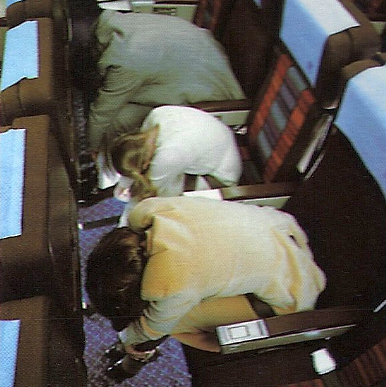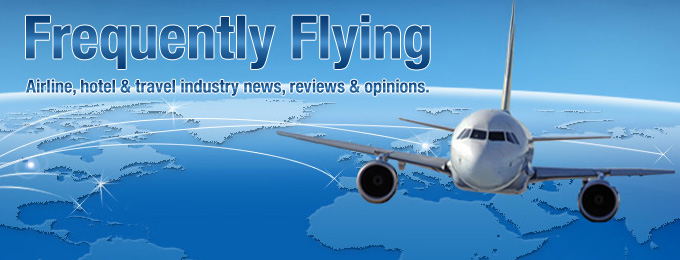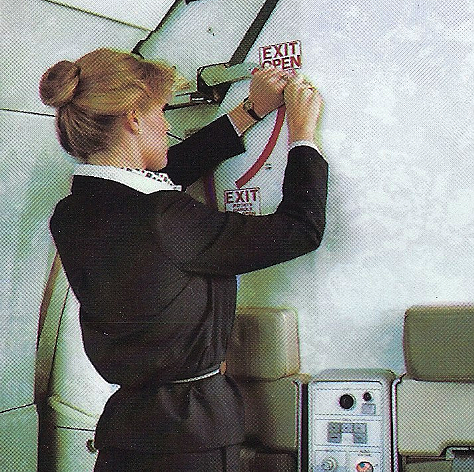An article appeared yesterday over at the Msnbc.com travel blog Overhead Bin entitled “Do you pay attention to airplane safety videos?†The writer admits she tunes the videos out when they begin having heard them countless times in the past. Experiencing severe turbulence on a recent flight, though, she checked for the lifejacket under the seat (it wasn’t there) and realized she had no idea how to open the overwing exits next to her. It was a reality check for her and it reminded me of my experience going through a mock crash at the United Airlines Denver Flight Training center (DENTK) in 1993 when I was an intern.
I boarded the full-sized sectional mock-up of a Boeing 767 with the rest of my group of interns and sat down with a smirk on my face. “Ha,†I thought, “I’ve flown a couple hundred thousand miles by now, this should be a piece of cake.†I was so cockily certain I’d get myself out in 90 seconds.
The flight attendants running the evacuation drill on the fully automated hydraulic simulator stated that beyond making their “Release seatbelts! Get out, leave everything behind!†commands after crashing, they would not assist in the process to evacuate.

Image courtesy United Airlines
We were airborne and the simulator had all the sounds and movement sensations of your typical 767. An emergency was declared and we were told to get into brace positions. Upon crashing (a slightly moderate jolt), the lights went out, smoke filled the cabin and it was pitch black. We were slightly askew in angle and the flight attendants shouted their command to release seatbelts.
I honestly don’t recall if the floor lights were on, but I do remember waving my hand in front of my face not being able to see a thing. The smoke smelled real and I began making my way to door 1L, the closest to where I was seated. I’d be lying if I said my heart wasn’t racing just a little.
I absolutely couldn’t believe the disorientation I was experiencing and struggled to gain my footing enough to feel my way up the row while bumping into everyone. After a few rows I thought I had reached the door, but instead found another row of seats. It seemed like an eternity, but I was the first to find the door and called back to everyone to come forward.
Did I remember to check outside for fire or impassable debris? Of course not. I was feeling for the handle and absolutely could not find it. My hands were frantically sweeping over all parts of the door while several more of my fellow interns started doing the same.
The lights came up to reveal a heavily smoke filled cabin and one of the flight attendants exclaimed, “Times up! You’re all dead. And had you opened that door you would have escaped into a burning fire.†I was so pissed.
That was my eye opening experience and I think most airlines leave off their safety videos the two most important things I learned that day:
- The common statement heard on videos today, “To open the exit, move the handle in the direction of the arrow,†is all fine and good with proper lighting, but if visibility is as poor as what I experienced, you need to know where the handle even is. So, when boarding I look for the handle position on the entry door or door immediately opposite. Some are built into the door and operate like a lever, some swing widely from left to right, some are on the wall to the right, etc. Now doing this post 9/11 can raise some eyes (“Why are you checking out the door handle?!â€), so I tend to be discreet about it. The same goes with the handle location on the overwing exits.
- Count the number of rows between you and the nearest exit. When it was pitch black, had I known how many rows there were between the door and me, I might have made it sooner through feel knowing I had X-more rows to pass. I think Air New Zealand has this in their safety videos, but definitely not United or American. The “locate the exit nearest your seat†statement on the videos only goes so far in that regard.
Do I remember to do this every time I fly? No, honestly I don’t and I again have gotten complacent with my expertise in flying. Hopefully if I were involved in an actual incident, the flight attendants wouldn’t be incapacitated as they were in my drill experience. I bet they got a chuckle out of all of us that day. I don’t really pay attention to the safety videos today either, but do sometimes stop what I’m doing if it’s a live demo and flight attendants are in the aisle.
So I’m curious, do you blow off the safety videos, play along and watch, or sometimes consider counting rows, etc?



When you are doing any kind of training and tell someone something they’ve known for years, they tune you out permanently.
Flight attendant speeches start with how to operate a seatbelt.
When I bought my first car (1968, a used 1962 Chevy convertible) my father bought me a present: Seatbelts. At that time it made sense to explain how to use them. Now, you can’t GET to the airport without using belts, so people stop listening. (I know, the latches are different in cars, but that doesn’t change how people react).
The speech needs to change, but I’m afraid the the paperwork to change it will never get done.
Steve, I completely understand what you mean; it seems silly to talk about seatbelts when possibly everyone who is on that plane may have used them, and people will tune out. However, the demo is not optional. It is required by federal regulation, and most regs are written in blood: they exist because somewhere along the line, someone was killed or injured as a result of the lack of knowledge or rule.
Also, people can react in unexpected ways in a crisis. A fully capable person could freeze during a crash fire and die still belted in. During the investigation, the question will be asked: is he dead becUse he froze, or because he wasn’t told how to release his belt? The crew must be able to prove they did the demo or be liable. Even asan FA for the government, flying only the same govt employees all the time, I am not exempt from the seatbelt demo–I even have to do it on the PA when I have only one pax, so it’s on the CVR as proof.
I don’t see the FAA ever getting rid of the requirement.
When I used to travel on business a lot my colleagues all thought I was afraid of flying because I made a point of observing how to get the doors and the emergency slides open and counting the rows between my seat and the doors. My thinking has always been that there is not much I can do to control events in an emergency situation, but I can, by God, avoid dying in one because I didn’t know how to get out of the airplane!
I always count the seats both ways. QF also specifically tells (and shows) you to count the seats in their safety video.
I also leave my shoes on for takeoff and landing. If you have to evacuate (takeoff and landing being the times you’re most likely to have a sudden need to evacuate), barring wearing high heels, you’re going to prefer having your shoes on. SK announces on their flights for pax to keep their shoes on during takeoff and landing.
Keeping your Passport in your pocket is a good idea, too. I see a lot of people leave it in their briefcase (I often see pax get their passport from their bag or briefcase to fill in the customs forms.) Imagine you were on the SQ flight in TPE that went down the closed runway. (I was ticketed on that flight, but thankfully changed a few days prior to departure! The people who were in the seats that I was assigned did survive.) If you were lucky enough to get off, dealing with the TPE border patrol without any identifying documents wouldn’t be fun.
I’ve thought about keeping my coat with me for winter departures, but I’ve decided that’s overkill. Hmm…
I forgot to add…thanks for sharing this experience. It really was enlightening.
Thanks for the comments everyone. Agreed the seatbelt operation is a bit mind numbing @NYBanker, I do the shoes thing, too. @Perl: as you say, I was surprised at how disoriented I was during the drill so understand how people could freeze in a high stress situation.
I always count rows front & back and check for a life preserver. Ditto with shoes (real shoes, not flip flops or the like). And I always wear long pants for a flight (I even change out of my shorts at the airport in Hawaii before I board to come home). As an ex-military pilot I had gone through similar training above and disorientation is a very real issue. We also did training for a water landing (blacked out swim goggles, cabin lands on its side and fills up with water in 60 seconds) – even when you are trained and ready it is just unbelievable how hard it is to get out of that situation. And I’ve thought about wearing my coat in the winter too! But haven’t gone that far yet.
I must admit, I don’t count how many rows are between me and the exit, but being in First or Business I can telly based on my ticket every time.
One thing I really don’t get is the people who either take off shoes right when they sit down or even go to sleep. No matter how tired I am, I will wait until the double chime for allowing electronics to be turned on before taking my shoes off and going to sleep.
Loved the post
I always count forward and back yes you are correct about air new Zealand
Hadn’t thought about the handle mechanism good point
The other time I count is in a hotel count the number of door ways to the exit stairs if you are crawling on the floor you can’t see the sign on the door
If traveling with my 11 and 8 year old sons always remind them that just because they tell you about what to do in an emergency doesn’t mean that it is going to happen after one trip where the eldest aged 5 cried that the plane was going to crash why else would they tell you what to do
Tell the eldest that if I tell him to do something on the flight he MUST do it no arguing
Not to wait for mummy but to get himself and his brother out after a tv programme where a child died because she wouldn’t leave her trapped mother and in a emergency because they are agile and small to consider going over the seats if the aisles are blocked
To remember to give the pilot a score for the landing also
I’ve never even thought about the hotel angle… good point!
Being a hotelier for more than 20 years by now, people still get annoyed when you do test drills with the fire department in the hotel. They give you bad ratings even online to harm you more, as they feel disturbed by it.
It is always the same dammed if you do, dammed if you don’t and something really happens. Nevertheless, I gave up to care about these complaints,we still do drills every 3 Month.